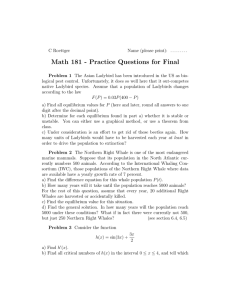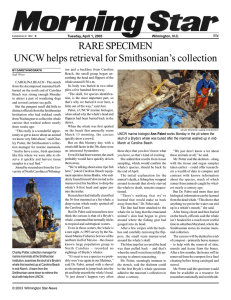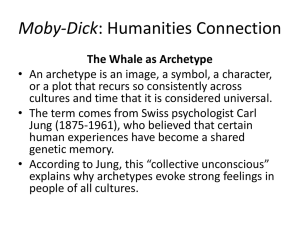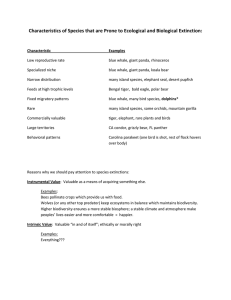Starved whale washes up on Carolina Beach shore
advertisement
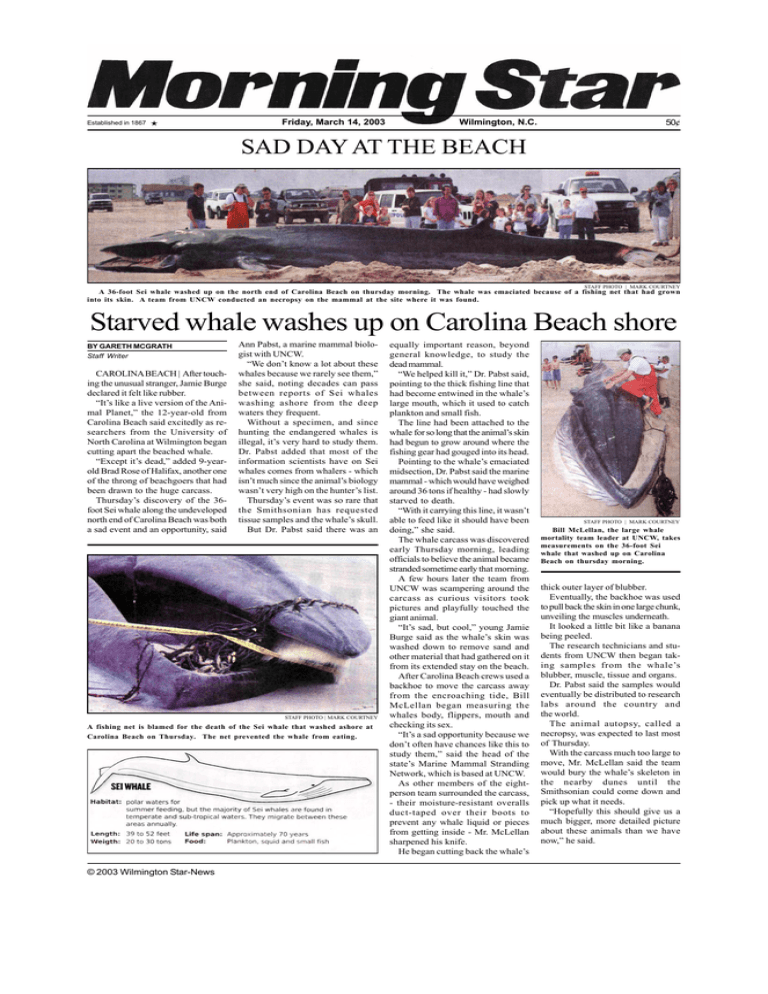
Established in 1867 Friday, March 14, 2003 Wilmington, N.C. 50¢ SAD DAY AT THE BEACH STAFF PHOTO | MARK COURTNEY A 36-foot Sei whale washed up on the north end of Carolina Beach on thursday morning. The whale was emaciated because of a fishing net that had grown into its skin. A team from UNCW conducted an necropsy on the mammal at the site where it was found. Starved whale washes up on Carolina Beach shore BY GARETH MCGRATH Staff Writer CAROLINA BEACH | After touching the unusual stranger, Jamie Burge declared it felt like rubber. “It’s like a live version of the Animal Planet,” the 12-year-old from Carolina Beach said excitedly as researchers from the University of North Carolina at Wilmington began cutting apart the beached whale. “Except it’s dead,” added 9-yearold Brad Rose of Halifax, another one of the throng of beachgoers that had been drawn to the huge carcass. Thursday’s discovery of the 36foot Sei whale along the undeveloped north end of Carolina Beach was both a sad event and an opportunity, said Ann Pabst, a marine mammal biologist with UNCW. “We don’t know a lot about these whales because we rarely see them,” she said, noting decades can pass between reports of Sei whales washing ashore from the deep waters they frequent. Without a specimen, and since hunting the endangered whales is illegal, it’s very hard to study them. Dr. Pabst added that most of the information scientists have on Sei whales comes from whalers - which isn’t much since the animal’s biology wasn’t very high on the hunter’s list. Thursday’s event was so rare that the Smithsonian has requested tissue samples and the whale’s skull. But Dr. Pabst said there was an STAFF PHOTO | MARK COURTNEY A fishing net is blamed for the death of the Sei whale that washed ashore at Carolina Beach on Thursday. The net prevented the whale from eating. © 2003 Wilmington Star-News equally important reason, beyond general knowledge, to study the dead mammal. “We helped kill it,” Dr. Pabst said, pointing to the thick fishing line that had become entwined in the whale’s large mouth, which it used to catch plankton and small fish. The line had been attached to the whale for so long that the animal’s skin had begun to grow around where the fishing gear had gouged into its head. Pointing to the whale’s emaciated midsection, Dr. Pabst said the marine mammal - which would have weighed around 36 tons if healthy - had slowly starved to death. “With it carrying this line, it wasn’t able to feed like it should have been doing,” she said. The whale carcass was discovered early Thursday morning, leading officials to believe the animal became stranded sometime early that morning. A few hours later the team from UNCW was scampering around the carcass as curious visitors took pictures and playfully touched the giant animal. “It’s sad, but cool,” young Jamie Burge said as the whale’s skin was washed down to remove sand and other material that had gathered on it from its extended stay on the beach. After Carolina Beach crews used a backhoe to move the carcass away from the encroaching tide, Bill McLellan began measuring the whales body, flippers, mouth and checking its sex. “It’s a sad opportunity because we don’t often have chances like this to study them,” said the head of the state’s Marine Mammal Stranding Network, which is based at UNCW. As other members of the eightperson team surrounded the carcass, - their moisture-resistant overalls duct-taped over their boots to prevent any whale liquid or pieces from getting inside - Mr. McLellan sharpened his knife. He began cutting back the whale’s STAFF PHOTO | MARK COURTNEY Bill McLellan, the large whale mortality team leader at UNCW, takes measurements on the 36-foot Sei whale that washed up on Carolina Beach on thursday morning. thick outer layer of blubber. Eventually, the backhoe was used to pull back the skin in one large chunk, unveiling the muscles underneath. It looked a little bit like a banana being peeled. The research technicians and students from UNCW then began taking samples from the whale’s blubber, muscle, tissue and organs. Dr. Pabst said the samples would eventually be distributed to research labs around the country and the world. The animal autopsy, called a necropsy, was expected to last most of Thursday. With the carcass much too large to move, Mr. McLellan said the team would bury the whale’s skeleton in the nearby dunes until the Smithsonian could come down and pick up what it needs. “Hopefully this should give us a much bigger, more detailed picture about these animals than we have now,” he said.
![Blue and fin whale populations [MM 2.4.1] Ecologists use the](http://s3.studylib.net/store/data/008646945_1-b8cb28bdd3491236d14c964cfafa113a-300x300.png)

